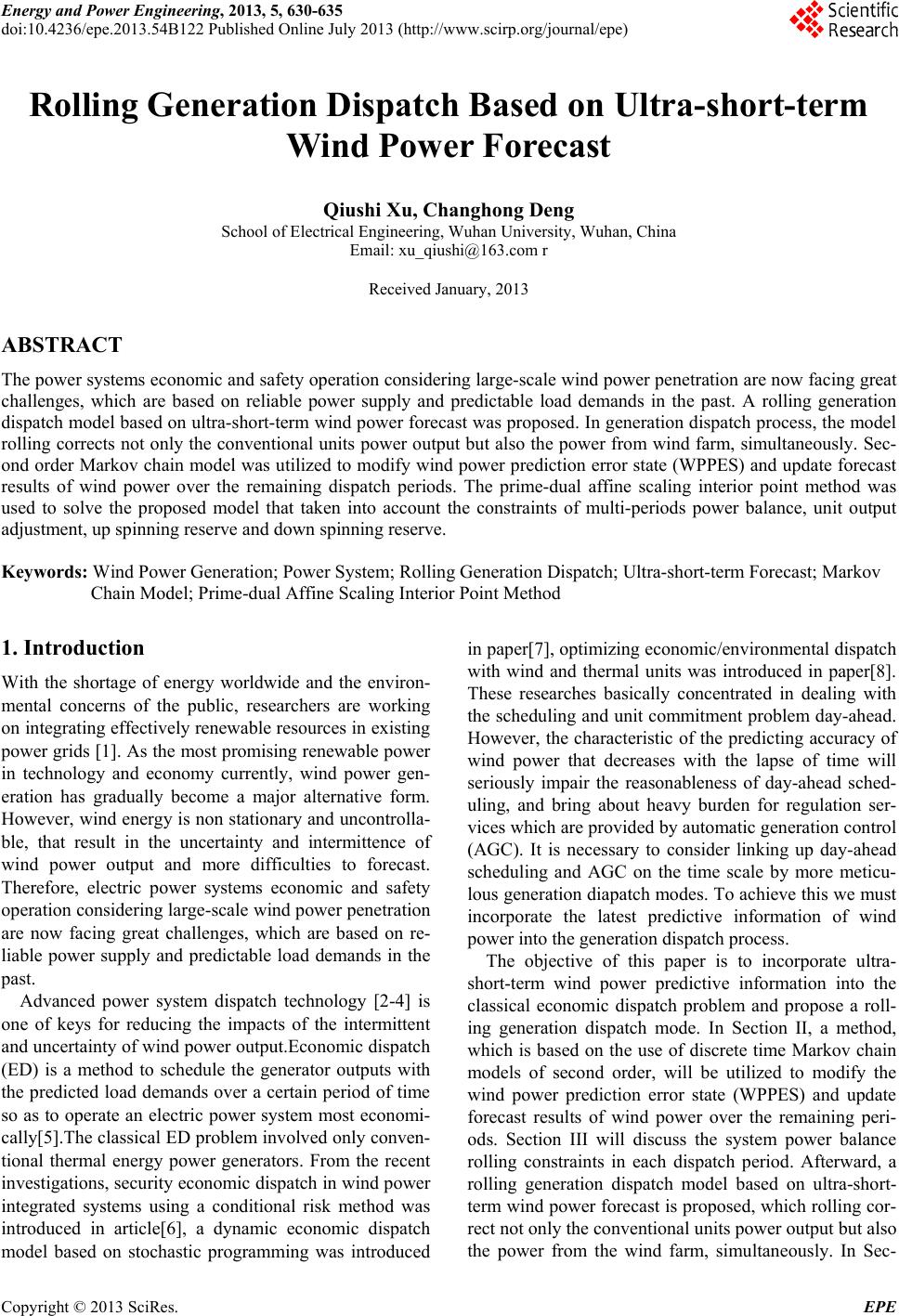 Energy and Power Engineering, 2013, 5, 630-635 doi:10.4236/epe.2013.54B122 Published Online July 2013 (http://www.scirp.org/journal/epe) Rolling Generation Dispatch Based on Ultra-short-term Wind Power Forecast Qiushi Xu, Changhong Deng School of Electrical Engineering, Wuhan University, Wuhan, China Email: xu_qiushi@163.com r Received January, 2013 ABSTRACT The power systems economic and safety operation considering large-scale wind power penetration are now facing great challenges, which are based on reliable power supply and predictable load demands in the past. A rolling generation dispatch model based on ultra-short-term wind power forecast was proposed. In generation dispatch process, the model rolling corrects not only the conventional units power output but also the power from wind farm, simultaneously. Sec- ond order Markov chain model was utilized to modify wind power prediction error state (WPPES) and upd ate forecast results of wind power over the remaining dispatch periods. The prime-dual affine scaling interior point method was used to solve the proposed model that taken into account the constraints of multi-periods power balance, unit output adjustment, up spinning reserve and down spinning reserve. Keywords: Wind Power Generation; Power System; Rolling Generation Dispatc h; Ultra-short-term Forecast; Markov Chain Model; Prime-dual Affine Scaling Interior Point Method 1. Introduction With the shortage of energy worldwide and the environ- mental concerns of the public, researchers are working on integrating effectively renewable resources in existing power grids [1]. As the most promising renewable power in technology and economy currently, wind power gen- eration has gradually become a major alternative form. However, wind energy is non stationary and uncontrolla- ble, that result in the uncertainty and intermittence of wind power output and more difficulties to forecast. Therefore, electric power systems economic and safety operation considering large-scale wind power penetration are now facing great challenges, which are based on re- liable power supply and predictable load demands in the past. Advanced power system dispatch technology [2-4] is one of keys for reducing the impacts of the intermittent and uncertainty of w ind power outpu t.Economic dispatch (ED) is a method to schedule the generator outputs with the predicted load demands over a certain period of time so as to operate an electric power system most economi- cally[5].The classical ED problem involved only conven- tional thermal energy power generators. From the recent investigations, security economic dispatch in wind power integrated systems using a conditional risk method was introduced in article[6], a dynamic economic dispatch model based on stochastic programming was introduced in paper[7], optimizing economic/en vironmental d ispatch with wind and thermal units was introduced in paper[8]. These researches basically concentrated in dealing with the scheduling and un it commitment problem day-ah ead. However, the characteristic of the predicting accuracy of wind power that decreases with the lapse of time will seriously impair the reasonableness of day-ahead sched- uling, and bring about heavy burden for regulation ser- vices which are provided by automatic generation con trol (AGC). It is necessary to consider linking up day-ahead scheduling and AGC on the time scale by more meticu- lous generation diapatch modes. To achieve this we must incorporate the latest predictive information of wind power into the generation dispatch process. The objective of this paper is to incorporate ultra- short-term wind power predictive information into the classical economic dispatch problem and propose a roll- ing generation dispatch mode. In Section II, a method, which is based on the use of discrete time Markov chain models of second order, will be utilized to modify the wind power prediction error state (WPPES) and update forecast results of wind power over the remaining peri- ods. Section III will discuss the system power balance rolling constraints in each dispatch period. Afterward, a rolling generation dispatch model based on ultra-short- term wind power forecast is proposed, which rolling cor- rect not only the conv entional units power output but also the power from the wind farm, simultaneously. In Sec- Copyright © 2013 SciRes. EPE 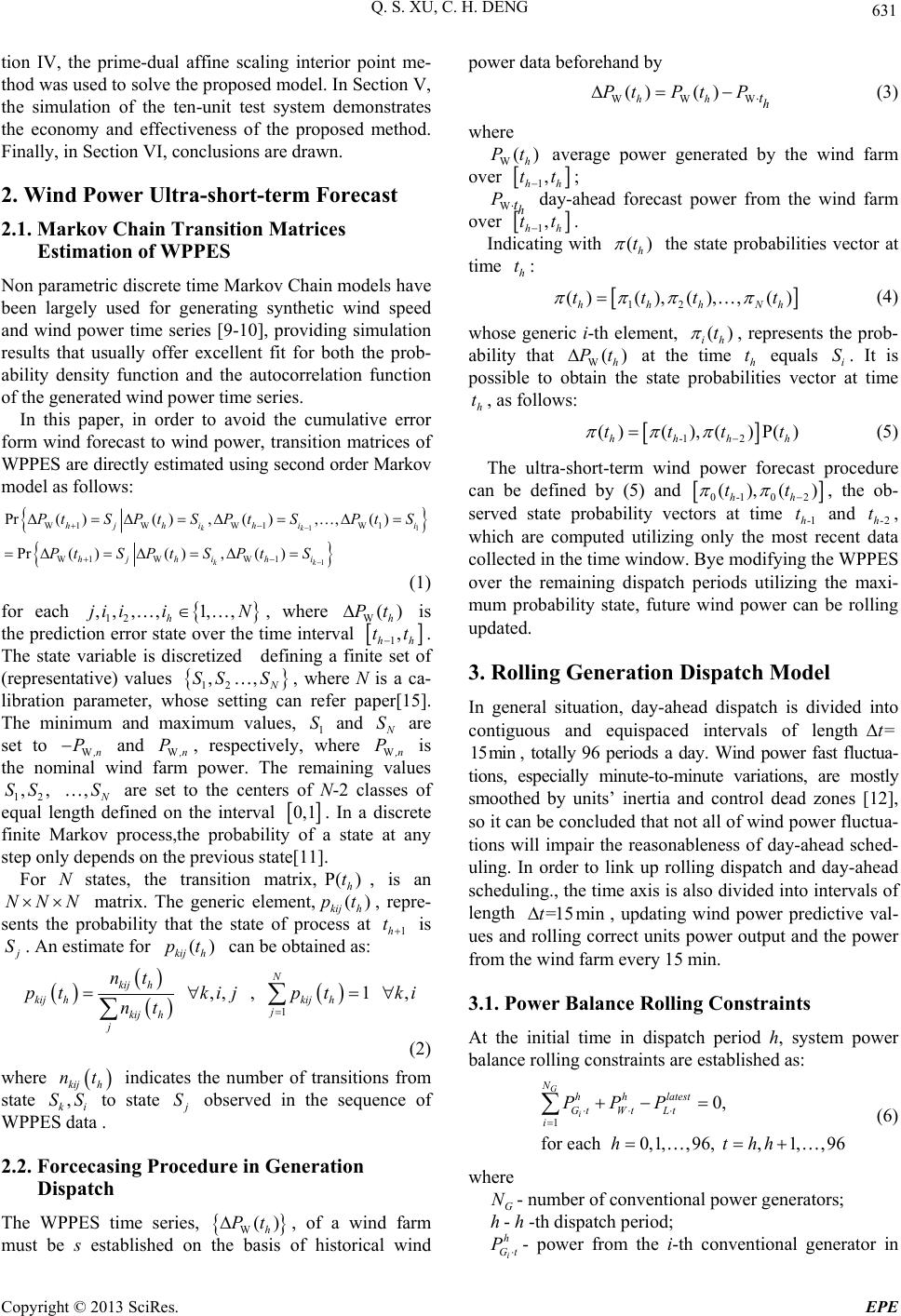 Q. S. XU, C. H. DENG 631 tion IV, the prime-dual affine scaling interior point me- thod was used to solv e th e p ropo sed mod el. In Section V, the simulation of the ten-unit test system demonstrates the economy and effectiveness of the proposed method. Finally, in Section VI, conclusions are drawn. 2. Wind Power Ultra-short-term Forecast 2.1. Markov Chain Transition Matrices Estimation of WPPES Non parametric discrete time Markov Chain models have been largely used for generating synthetic wind speed and wind power time series [9-10], providing simulation results that usually offer excellent fit for both the prob- ability density function and the autocorrelation function of the generat ed wind power time series. In this paper, in order to avoid the cumulative error form wind forecast to wind power, transition matrices of WPPES are directly estimated using second order Markov model as follows: 1 1 W1 WW1W1 W1 WW1 Pr()(),(),,( ) Pr()( ),() kk kk hjhi hi hjhi hi 1 i tS PtSPtSPtS PtSPtSPtS (1) for each , where is the prediction erro r state over the time interval 12 ,,,,1,, h ji iiN W() h Pt 1, h t h . The state variable is discretized defining a finite set of (representative) values , where N is a ca- libration parameter, whose setting can refer paper[15]. The minimum and maximum values, 1 and t 12 ,SS , N S S S re Pvalu are set to W,n and W,n , respectively, wheW,n is the nominal wind farm power. The remaining 12 , P P ,es ,SS S are set to the centers of N-2 classes of equal length defined on the inte rval 0,1 . In a discrete finite Markov process,the probability of a state at any step only depends on t he pre vious state[11] . For N states, the transition matrix,, is an matrix. The generic element,, repre- sents the probability that the state of process at P( ) h t( kij h ptNNN ) 1h t is S. An estimate for can be obtained as: () kij h pt 1 ,, ,1, N kij h kij hkij h j kij h j nt ptkijptki nt (2) where indicates the number of transitions from state to state kij h nt , ki SS S observed in the sequence of WPPES dat a . 2.2. Forcecasing Procedure in Generation Dispatch The WPPES time series, W, of a wind farm must be s established on the basis of historical wind power data beforehand by WWW () () hh h t PtPt P (3) where W average power generated by the wind farm over () h Pt 1, h t Ph W t; h t day-ahead forecast power from the wind farm over 1, hh tt . Indicating with () h t the state probabilities vector at time : h t 12 ()(),(), ,() hhhN tttt h (4) whose generic i-th element, () ih t , represents the prob- ability that W() h Pt at the time h t equals i. It is possible to obtain the state probabilities vector at time , as follows: S h t -1 2 ()( ),()P() hhh ttt h t (5) The ultra-short-term wind power forecast procedure can be defined by (5) and 0-1 02 (),() hh tt t, the ob- served state probability vectors at time -1h and -2h, which are computed utilizing only the most recent data collected in the time window. Bye modifying the WPPES over the remaining dispatch periods utilizing the maxi- mum probability state, future wind power can be rolling updated. t 3. Rolling Generation Dispatch M odel In general situation, day-ahead dispatch is divided into contiguous and equispaced intervals of length=t , totally 96 periods a day. Wind power fast fluctua- tions, especially minute-to-minute variations, are mostly smoothed by units’ inertia and control dead zones [12], so it can be con cluded that no t all of wind p ower fluctua- tions will impair the reasonableness of day-ahead sched- uling. In order to link up rolling dispatch and day-ahead scheduling., the time axis is also div ided into intervals of length 15min =15 mint , updating wind power predictive val- ues and rolling correct units power output and the power from the wind farm every 15 min. 3.1. Power Balance Rolling Constraints At the initial time in dispatch period h, system power balance rolling constraints are established as: 10, for each0,1,,96, ,1,,96 G i Nhh latest Gt WtLt i PPP hthh (6) where G - h -th dispatch period; N h- number of conve ntio nal po wer ge nerat ors; () h Pt i Gt Ph - power from the i-th conventional generator in Copyright © 2013 SciRes. EPE 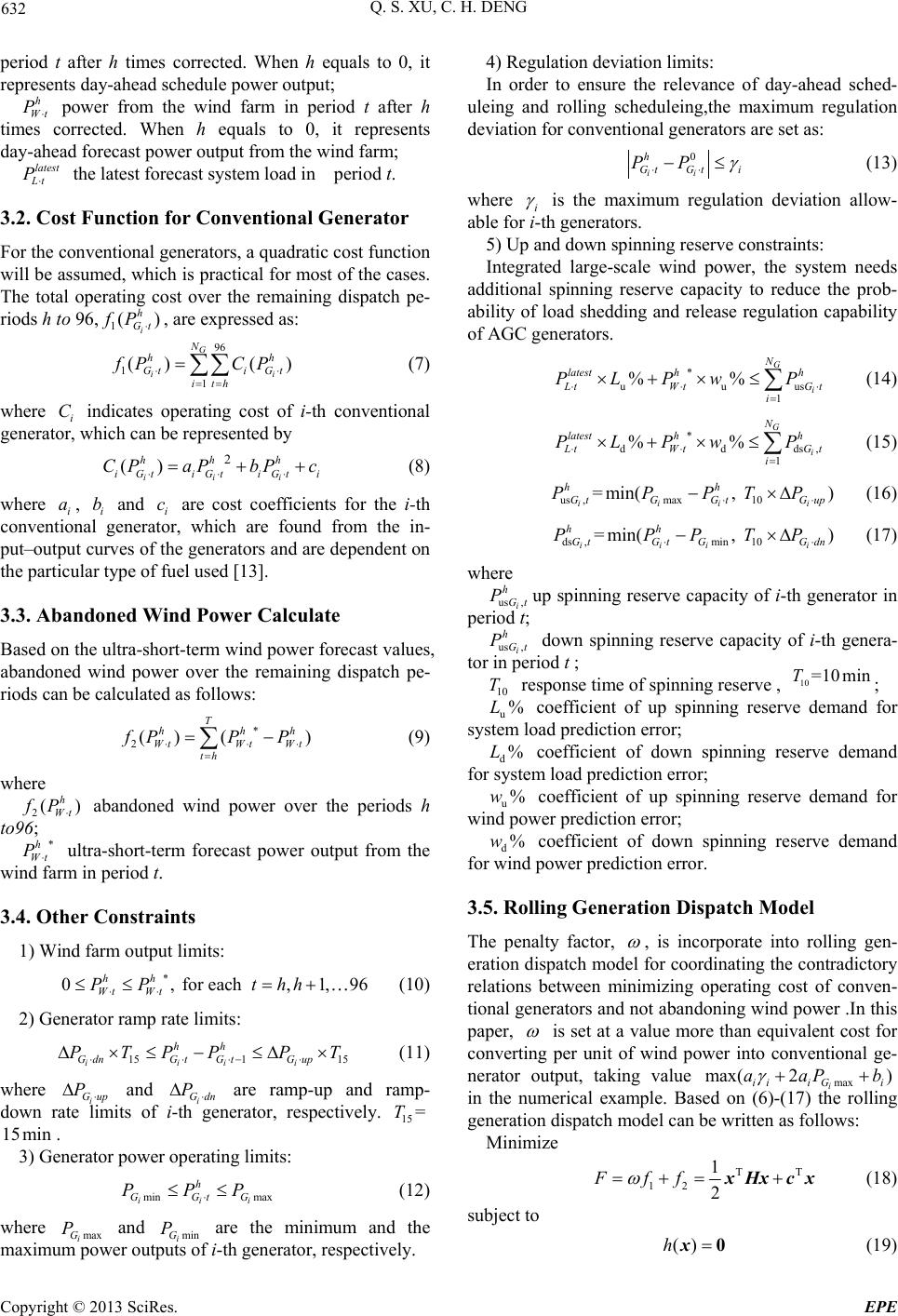 Q. S. XU, C. H. DENG 632 period t after h times corrected. When h equals to 0, it represents day-ahead schedule power output; h Wt P power from the wind farm in period t after h times corrected. When h equals to 0, it represents day-ahead forecast power output from the wind farm; latest Lt P the latest forecast system load in period t. 3.2. Cost Function for Conventional Generator For the conventional generators, a quadratic cost function will be assumed, which is practical for most of the cases. The total operating cost over the remaining dispatch pe- riods h to 96, , are expressed as: 1( i h Gt fP ) ) i h ) h ) 96 11 () ( G i N h Gti Gt ith fP CP (7) where i indicates operating cost of i-th conventional generator, which can be repre sented by C 2 () iii hhh iGtiGtiGt i CPaPbPc (8) where i, i and i c are cost coefficients for the i-th conventional generator, which are found from the in- put–output curves of the generators and are dependent on the particular type of fuel used [13]. a b 3.3. Abandoned Wind Power Calculate Based on the ultra-short-term wind power forecast values, abandoned wind power over the remaining dispatch pe- riods can be calculated as follows: * 2() ( T hh WtWt Wt th fPP P (9) where 2( h Wt P abandoned wind power over the periods h to96; *h Wt P ultra-short-term forecast power output from the wind farm in period t. 3.4. Other Constraints 1) Wind farm output limits: * 0, for each ,1,96 hh Wt Wt PP thh (10) 2) Generator ramp rate limits: 151 15 iiii hh GdnGt GtGup PTPP PT (11) where i Gup and i Gdn are ramp-up and ramp- down rate limits of i-th generator, respectively. . P P 15 =T 15min 3) Generator power operating limits: min max iii h GGtG PPP (12) where max i G and min i G are the minimum and the maximum powe r ou tputs of i-th generator, respectively. P P 4) Regulation deviation limits: In order to ensure the relevance of day-ahead sched- uleing and rolling scheduleing,the maximum regulation deviation for conventional generators are set as: 0 ii h GtGti PP (13) where i is the maximum regulation deviation allow- able for i-th generators. 5) Up and down spinning reserve constraints: Integrated large-scale wind power, the system needs additional spinning reserve capacity to reduce the prob- ability of load shedding and release regulation capability of AGC generators. * uu 1 %% G i N latest hh us tWt i PLPw P Gt (14) * dd 1 %% G i N latest hh ds, tWt i PLPwP Gt i i (15) us ,max10 =min(, ) iii hh GtG GtGup PPPTP (16) ds ,min10 =min( , ) iii hh GtGt GGdn PPPTP (17) where us , iup spinning reserve capacity of i-th generator in period t; hGt P us , i down spinning reserve capacity of i-th genera- tor in period t ; hGt P 10 T%L response time of spinning reserve , ; 10 =10minT u coefficient of up spinning reserve demand for system load prediction error; d coefficient of down spinning reserve demand for system load prediction error; %L u coefficient of up spinning reserve demand for wind pow er pre d i c t i o n e rror; %w d coefficient of down spinning reserve demand for win d p ower pr ediction e rror. %w 3.5. Rolling Generation Dispatch Model The penalty factor, , is incorporate into rolling gen- eration dispatch model for coordinating the contradictory relations between minimizing operating cost of conven- tional generators and not abandoning wind power .I n this paper, is set at a value more than equivalent cost for converting per unit of wind power into conventional ge- nerator output, taking value max i iiiGi in the numerical example. Based on (6)-(17) the rolling generation dispatch model can be written as follows: max( 2)aaPb Minimize T 12 1 2 Fff xHxcx T (18) subject to () hx0 (19) Copyright © 2013 SciRes. EPE 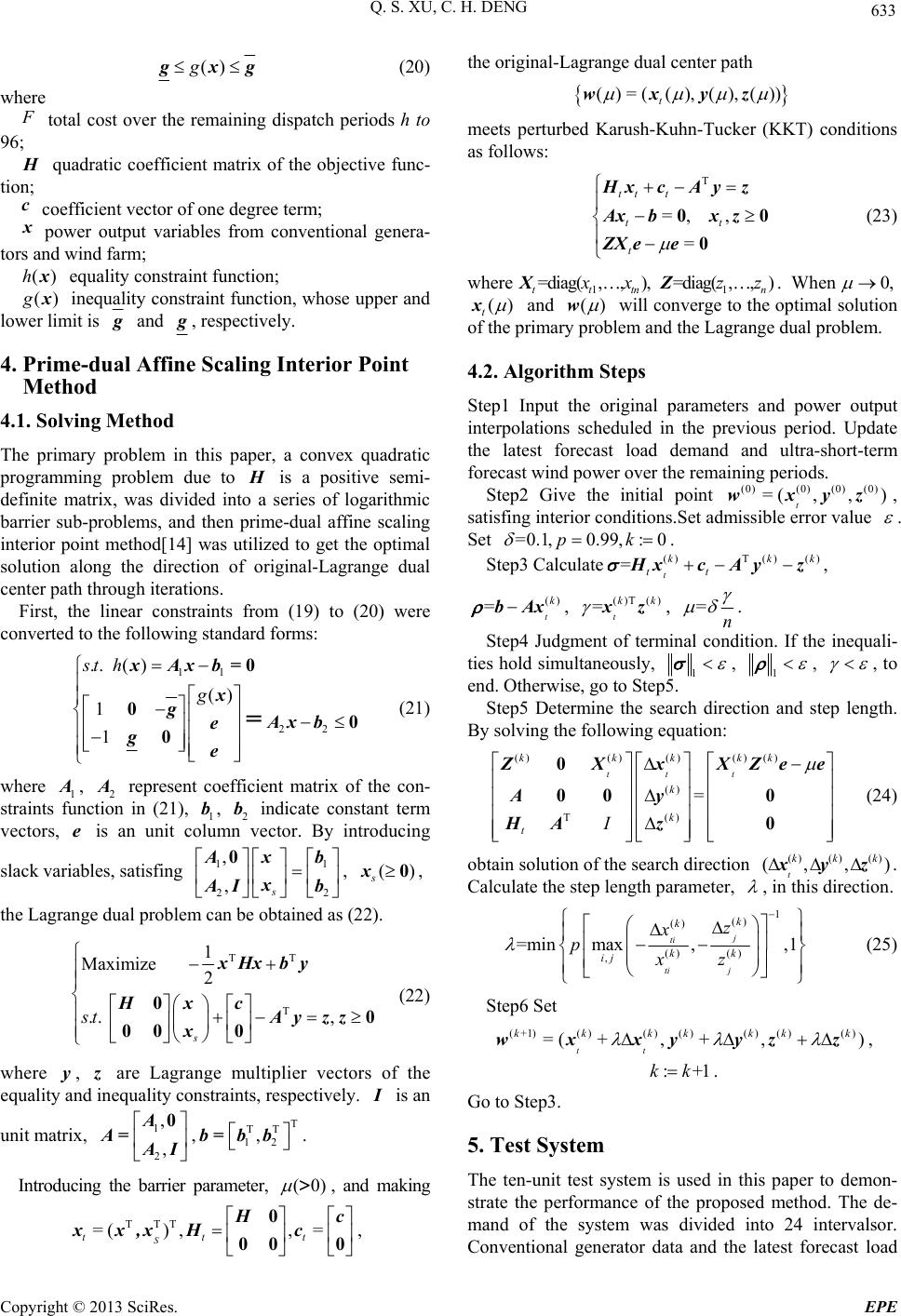 Q. S. XU, C. H. DENG 633 ()g x (20) where F total cost over the remaining dispatch periods h to 96; quadratic coefficient matrix of the objective func- tion; c coefficient vector of one degree term; x power output variables from conventional genera- tors and wind farm ; ()hx ()gx equality constraint function; inequality constraint function, whose upper and lower limit is g and g, respectively. 4. Prime-dual Affine Scaling Interior Point Method 4.1. Solving Method The primary problem in this paper, a convex quadratic programming problem due to is a positive semi- definite matrix, was divided into a series of logarithmic barrier sub-problems, and then prime-dual affine scaling interior point method[14] was utilized to get the optimal solution along the direction of original-Lagrange dual center path through iterations. First, the linear constraints from (19) to (20) were converted to the following standard forms: 11 22 .. () () 1 1 sth g xAxb= x gAx b e ge = 0 00 0 (21) where 1, 2 represent coefficient matrix of the con- straints function in (21), 1, 2 indicate constant term vectors, is an unit column vector. By introducing A e Ab b slack variables, satisfing , , 1 22 , ,s Ab x x AI b 01 () sx0 the Lagrange dual problem can be obtained as (22). TT T 1 Maximize 2 .. , s st xHxby x Hc Ay zz x 00 00 0 (22) where , y are Lagrange multiplier vectors of the equality and inequality constraints, respectively. is an I unit matrix, , 1 2 , , A A= AI 0T TT 12 , b= bb. Introducing the barrier parameter, (0) >, and making TTT =(),,= S ttt the original-Lagrange dual center path ()=( (),(),()) t wxyz meets perturbed Karush-Kuhn-Tucker (KKT) conditions as follows: T =,, = tt t tt t xcAyz Axbx z ZX ee 0 0 0 (23) where n1 =diag( ,,), ttt xX 1. When =diag( ,,) n zzZ0, t() x and () w will converge to the opti mal solution of the primary problem and the Lagrange dual problem. 4.2. Algorithm Steps Step1 Input the original parameters and power output interpolations scheduled in the previous period. Update the latest forecast load demand and ultra-short-term forecast wind po w er ove r the remaining periods. Step2 Give the initial point t (0)(0)(0) (0) =(,,)wx z, satisfing interior conditions.Set admissible er ror value . Set =0.1,0.99,: 0pk () . Step3 CalculateT ()()kkk =t tt xcA z ()T () t kk xz , , , () =t k bAx = =n . Step4 Judgment of terminal condition. If the inequali- ties hold simultaneously, 1 , 1 , , to end. Otherwise, go to Step5. Step5 Determine the search direction and step length. By solving the following equation: ()()()() () () T() = tt t kkkkk k k tI ZXxXZe Ay HA z 0 00 0 0 e ) (24) obtain solution of the search directio n t ()()() (,, kkk x z. Calculate the step length parameter, , in this direction. 1 () () () () , =min max,,1 j ti ti j k k kk ij z x pxz (25) Step6 Set (+1)()()()() ()() =( +,+,) tt kkkkkk wxxyyzz :+ 1 kk k , . Go to Step3. 5. Test System The ten-unit test system is used in this paper to demon- strate the performance of the proposed method. The de- mand of the system was divided into 24 intervalsor. Conventional generator data and the latest forecast load c xx,xH c 0 00 0 , Copyright © 2013 SciRes. EPE  Q. S. XU, C. H. DENG Copyright © 2013 SciRes. EPE 634 data can be found in Ta ble s 1 an d 2. The test system was integrated with a wind farm, described by operation data of an actual wind farm, including 56 wind turbines of 2.5 MW, totally 140 MW. Curves of wind power drawn based on day-ahead forecast date, ultra-short-term forecast date obtained through second order Markov model and actual output date one day can be seen in Fig. 1. In general, the trends in curve 1 are much more similar to those in curve 3 then in curve 2. Figure 1 also shows that scheduleing only according to day-ahead forecast will result in a certain difference, which will impair the reasonableness of con- ventional generators power output scheduling ,and may cause a waste of wind energy resources. Table 1. Latest Load forecast data. Hour Load (MW) Hour Load (MW) Hour Load (MW) 1 1096 9 1984 17 1540 2 1170 10 2132 18 1688 3 1318 11 2206 19 1836 4 1466 12 2280 20 2132 5 1540 13 2132 21 1984 6 1688 14 1984 22 1688 7 1762 15 1836 23 1392 8 1836 16 1614 24 1244 Table 2. Conventional generators data. Unit maxGi P (MW) minGi P (MW) i a ($/(MW2•h))i b ($/(MW•h))i c ($/h)i Gup P , (MW/min) i Gdn P, (MW/min) 1 470 150 0.043 21.60 958 4.70 -4.70 2 460 135 0.063 21.05 1313 4.60 -4.60 3 340 73 0.039 20.80 604 3.80 -3.80 4 300 60 0.070 23.90 471 3.53 -3.53 5 260 57 0.056 17.87 601 3.70 -3.70 6 243 73 0.079 21.62 480 3.33 -3.33 7 130 20 0.211 16.51 502 2.00 -2.00 8 120 15 0.480 23.23 639 1.20 -1.20 9 80 10 1.091 19.58 455 0.80 -0.80 10 55 55 0.951 22.54 692 0.55 -0.55 0 20 40 60 80 100 120 0 163248648096 curve1(day-ahead forecast) curve2(ultra-short-term forecast) curve3(actual output) Figure 1. Curves of wind power forecast and actual output of 24-hours. 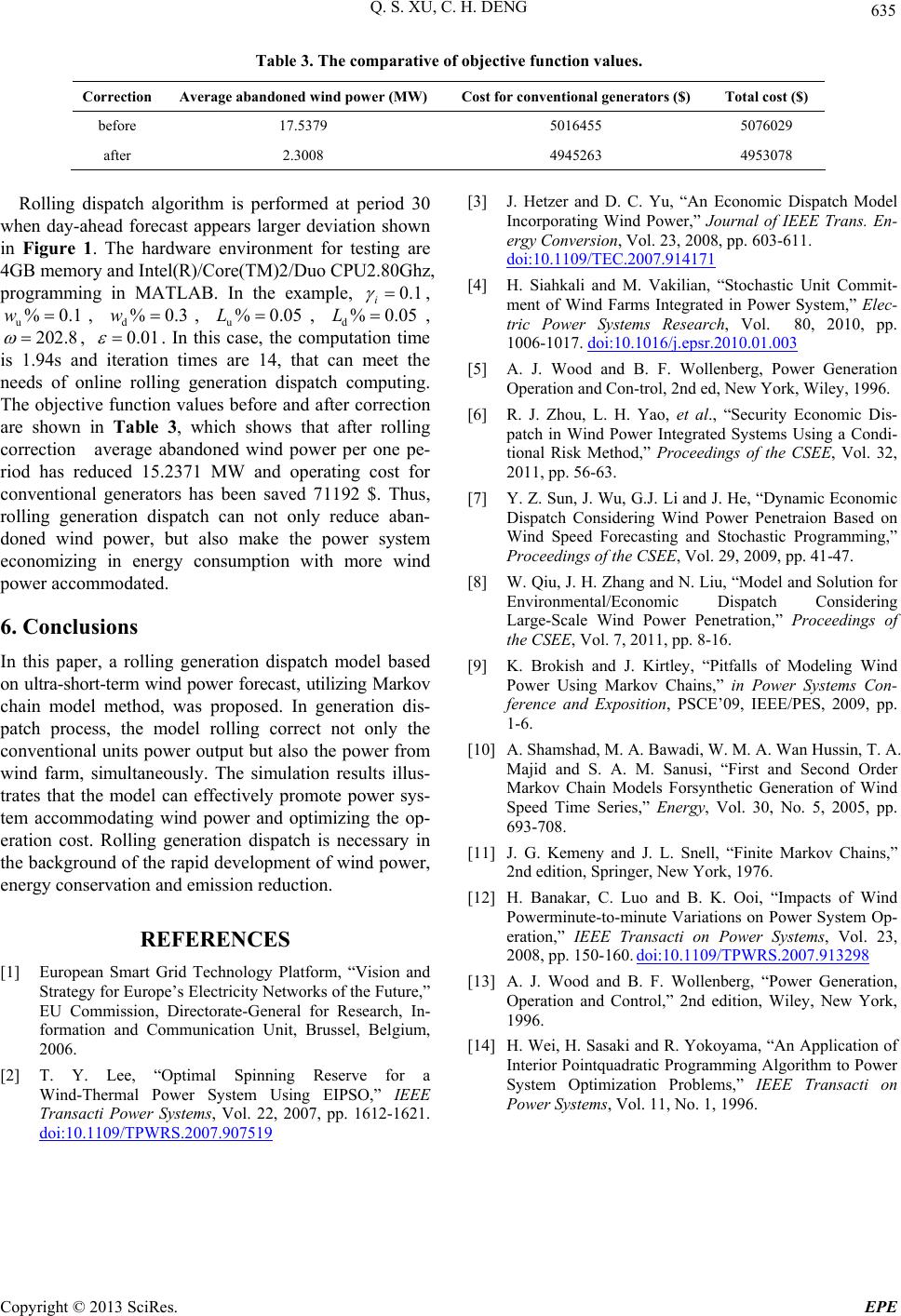 Q. S. XU, C. H. DENG 635 Table 3. The comparative of objective function values. Correction Average abandoned wind power (MW) Cost for conventional generators ($) Total cost ($) before 17.5379 5016455 5076029 after 2.3008 4945263 4953078 Rolling dispatch algorithm is performed at period 30 when day-ahead forecast appears larger deviation shown in Figure 1. The hardware environment for testing are 4GB memory and Intel(R)/Core(TM)2/Duo CPU2.80Ghz, programming in MATLAB. In the example, 0.1 i , , , u, du %0.1wd%0.3w%0.05L%0.05L , 202.8 , 0.01 . In this case, the computation time is 1.94s and iteration times are 14, that can meet the needs of online rolling generation dispatch computing. The objective function values before and after correction are shown in Table 3, which shows that after rolling correction average abandoned wind power per one pe- riod has reduced 15.2371 MW and operating cost for conventional generators has been saved 71192 $. Thus, rolling generation dispatch can not only reduce aban- doned wind power, but also make the power system economizing in energy consumption with more wind power accommodated. 6. Conclusions In this paper, a rolling generation dispatch model based on ultra-short-term wind power forecast, utilizing Markov chain model method, was proposed. In generation dis- patch process, the model rolling correct not only the convention al units power output but also the power from wind farm, simultaneously. The simulation results illus- trates that the model can effectively promote power sys- tem accommodating wind power and optimizing the op- eration cost. Rolling generation dispatch is necessary in the background of the rapid development of wind power, energy conservation and emission reduction. REFERENCES [1] European Smart Grid Technology Platform, “Vision and Strategy for Europe’s Electricity Networks of the Future,” EU Commission, Directorate-General for Research, In- formation and Communication Unit, Brussel, Belgium, 2006. [2] T. Y. Lee, “Optimal Spinning Reserve for a Wind-Thermal Power System Using EIPSO,” IEEE Transacti Power Systems, Vol. 22, 2007, pp. 1612-1621. doi:10.1109/TPWRS.2007.907519 [3] J. Hetzer and D. C. Yu, “An Economic Dispatch Model Incorporating Wind Power,” Journal of IEEE Trans. En- ergy Conversion, Vol. 23, 2008, pp. 603-611. doi:10.1109/TEC.2007.914171 [4] H. Siahkali and M. Vakilian, “Stochastic Unit Commit- ment of Wind Farms Integrated in Power System,” Elec- tric Power Systems Research, Vol. 80, 2010, pp. 1006-1017. doi:10.1016/j.epsr.2010.01.003 [5] A. J. Wood and B. F. Wollenberg, Power Generation Operation and Con-trol, 2nd ed, New York, Wiley, 1996. [6] R. J. Zhou, L. H. Yao, et al., “Security Economic Dis- patch in Wind Power Integrated Systems Using a Condi- tional Risk Method,” Proceedings of the CSEE, Vol. 32, 2011, pp. 56-63. [7] Y. Z. Sun, J. Wu, G.J. Li and J. He, “Dynamic Economic Dispatch Considering Wind Power Penetraion Based on Wind Speed Forecasting and Stochastic Programming,” Proceedings of the CSEE, Vol. 29, 2009, pp. 41-47. [8] W. Qiu, J. H. Zhang and N. Liu, “Model and Solution for Environmental/Economic Dispatch Considering Large-Scale Wind Power Penetration,” Proceedings of the CSEE, Vol. 7, 2011, pp. 8-16. [9] K. Brokish and J. Kirtley, “Pitfalls of Modeling Wind Power Using Markov Chains,” in Power Systems Con- ference and Exposition, PSCE’09, IEEE/PES, 2009, pp. 1-6. [10] A. Shamshad, M. A. Bawadi, W. M. A. Wan Hussin, T. A. Majid and S. A. M. Sanusi, “First and Second Order Markov Chain Models Forsynthetic Generation of Wind Speed Time Series,” Energy, Vol. 30, No. 5, 2005, pp. 693-708. [11] J. G. Kemeny and J. L. Snell, “Finite Markov Chains,” 2nd edition, Springer, New York, 1976. [12] H. Banakar, C. Luo and B. K. Ooi, “Impacts of Wind Powerminute-to-minute Variations on Power System Op- eration,” IEEE Transacti on Power Systems, Vol. 23, 2008, pp. 150-160. doi:10.1109/TPWRS.2007.913298 [13] A. J. Wood and B. F. Wollenberg, “Power Generation, Operation and Control,” 2nd edition, Wiley, New York, 1996. [14] H. Wei, H. Sasaki and R. Yokoyama, “An Application of Interior Pointquadratic Programming Algorithm to Power System Optimization Problems,” IEEE Transacti on Power Systems, Vol. 11, No. 1, 1996. Copyright © 2013 SciRes. EPE
|